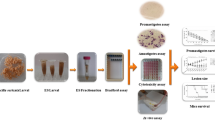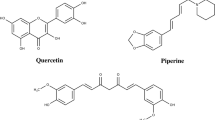Abstract
The purpose of this study is to evaluate the toxicity of synthetic chalcones 1 and 2 in uninfected hamsters and anti-Leishmania activity of synthetic chalcones 1 and 2 in hamsters infected with Leishmania (Viannia) braziliensis. For the toxicity test, uninfected animals were treated with chalcones 1 and 2, and clinical and biochemical parameters and histological aspects of the liver and kidneys were assessed. Chalcones 1 and 2 were then intraperitoneally or topically administered (10 mg/kg body weight) three times per week in animals infected with promastigotes of L. (V.) braziliensis. We monitored the thickness of the infected footpads, determined parasitic load, performed histological analysis, and detected apoptosis in situ. The results were analyzed using Student’s t test and Mann-Whitney test at a significance level of 5 %. Neither of the chalcones showed toxicity. Chalcone 2 administered intraperitoneally significantly reduced the thickness of the infected footpad compared with the beginning of treatment. The parasite load of the lymph node and spleen was reduced in the groups treated with chalcones 1 (topical) and 2 (intraperitoneal). Chalcone 2 (topical) reduced parasite burden only in the lymph node. The histological analysis revealed reconstitution of the tissue and reductions of inflammation and apoptosis in the infected footpad in these groups. The synthetic chalcones 1 (topical) and 2 (intraperitoneal and topical) at a dose of 10 mg/kg showed anti-Leishmania activity in vivo, no renal or hepatic toxicity, and a reduction of apoptosis of the cells in the lesions. These chalcones may have substantial potential for the treatment of cutaneous leishmaniasis.








Similar content being viewed by others
References
Almeida OL, Santos JB (2011) Advances in the treatment of cutaneous leishmaniasis in the new world in the last ten years: a systematic literature review. An Bras Dermatol 86:497–506. doi:10.1590/S0365-05962011000300012
Andrighetti-Frohner CR, de Oliveira KN, Gaspar-Silva D, Pacheco LK, Joussef AC, Steindel M, Simões CMO, de Souza AMT, Magalhaes UO, Afonso IF, Rodrigues CR, Nunes RJ, Castro HC (2009) Synthesis, biological evaluation and SAR of sulfonamide 4-methoxychalcone derivatives with potential antileishmanial activity. Eur J Med Chem 44:755–763. doi:10.1016/j.ejmech.2008.04.016
Aponte JC, Castillo D, Estevez Y, Gonzalez G, Arevalo J, Hammond GB, Sauvain M (2010) In vitro and in vivo anti-Leishmania activity of polysubstituted synthetic chalcones. Bioorg Med Chem Lett 20:100–103. doi:10.1016/j.bmcl.2009.11.033
Arevalo J, Ramirez L, Adaui V, Zimic M, Tulliano G, Miranda-Verástegui C, Lazo M, Loayza-Muro R, de Doncker S, Maurer A, Chappuis F, Dujardin JC, Llanos-Cuentas A (2007) Influence of Leishmania (Viannia) species on the response to antimonial treatment in patients with American tegumentary leishmaniasis. J Infect Dis 195:1846–1851. doi:10.1086/518041
Boeck P, Falcao CAB, Leal PC, Yunes RA, Filho VC, Torres-Santos EC, Rossi-Bergmann B (2006) Synthesis of chalcone analogues with increased antileishmanial activity. Bioorg Med Chem 14:1538–1545. doi:10.1016/j.bmc.2005.10.005
Buffet PA, Sulahian A, Garin YJ, Nassar N, Derouin F (1995) Culture microtitration: a sensitive method for quantifying Leishmania infantum in tissues of infected mice. Antimicrob Agents Chemother 39:2167–2168
Chen M, Christensen SB, Blom J, Lemmich E, Nadelmann L, Fich K, Theander TG, Kharazmi A (1993) Licochalcone A, a novel antiparasitic agent with potent activity against human pathogenic protozoan species of Leishmania. Antimicrob Agents Chemother 37:2550–2556. doi:10.1128/AAC.37.12.2550
Chen M, Christensen SB, Theander TG, Kharazmi A (1994) Antileishmanial activity of licochalcone A in mice infected with Leishmania major and in hamsters infected with Leishmania donovani. Antimicrob Agents Chemother 38:1339–1344. doi:10.1128/AAC.38.6.1339
de Mello TF, Bitencourt HR, Pedroso RB, Aristides SMA, Lonardoni MVC, Silveira TGV (2014) Leishmanicidal activity of synthetic chalcones in Leishmania (Viannia) braziliensis. Exp Parasitol 136:27–34. doi:10.1016/j.exppara.2013.11.003
Eidsmo L, Nylén S, Khamesipour A, Hedblad MA, Chiodi F, Akuffo H (2005) The contribution of the Fas/FasL apoptotic pathway in ulcer formation during Leishmania major-induced cutaneous Leishmaniasis. Am J Pathol 166:1099–1108. doi:10.1016/S0002-9440(10)62330-9
Foroumadi A, Emami S, Sorkhi M, Nakhjiri M, Nazarian Z, Heydari S, Ardestani SK, Poorrajab F, Shafiee A (2010) Chromene-based synthetic chalcones as potent antileishmanial agents: synthesis and biological activity. Chem Biol Drug Des 75:590–596. doi:10.1111/j.1747-0285.2010.00959.x
Franco LL, de Almeida MV, Rocha e Silva LF, Vieira PPR, Pohlit AM, Valle MS (2012) Synthesis and antimalarial activity of dihydroperoxides and tetraoxanes conjugated with bis(benzyl)acetone derivatives. Chem Biol Drug Des 79:790–797. doi:10.1111/j.1747-0285.2012.01345.x
Gomes-Silva A, Valverde JG, Ribeiro-Romao RP, Plácido-Pereira RM, Da-Cruz AM (2013) Golden hamster (Mesocricetus auratus) as an experimental model for Leishmania (Viannia) braziliensis infection. Parasitology 140:771–779. doi:10.1017/S0031182012002156
Hermoso A, Jimenez IA, Mamani ZA, Bazzocchi IL, Piñero JE, Ravelo AG, Valladares B (2003) Antileishmanial activities of dihydrochalcones from Piper elongatum and synthetic related compounds. Structural requirements for activity. Bioorg Med Chem 11:3975–3980. doi:10.1016/S0968-0896(03)00406-1
Laurenti MD, Sotto MN, Corbett CE, da Matta VL, Duarte MI (1990) Experimental visceral leishmaniasis: sequential events of granuloma formation at subcutaneous inoculation site. Int J Exp Pathol 71:791–797
Lindoso JA, Cotrim PC, Goto H (2004) Apoptosis of Leishmania (Leishmania) chagasi amastigotes in hamsters infected with visceral leishmaniasis. Int J Parasitol 34:1–4. doi:10.1016/j.ijpara.2003.09.010
Liu M, Wilairat P, Croft SL, Tan ALC, Go ML (2003) Structure-activity relationships of antileishmanial and antimalarial chalcones. Bioorg Med Chem 11:2729–2738. doi:10.1016/S0968-0896(03)00233-5
Lunardi F, Guzela M, Rodrigues AT, Côrrea R, Eger-Mangrich I, Steindel M, Grisard EC, Assreuy J, Calixto JB, Santos ARS (2003) Trypanocidal and leishmanicidal properties of substitution-containing chalcones. Antimicrob Agents Chemother 47:1449–1451. doi:10.1128/AAC.47.4.1449-1451.2003
Monzote L, Garcia M, Scull R, Cuellar A, Setzer WN (2013) Antileishmanial activity of the essential oil from Bixa orellana. Phytother Res. doi:10.1002/ptr.5055
Nylén S, Eidsmo L (2012) Tissue damage and immunity in cutaneous leishmaniasis. Parasite Immunol 34:551–561. doi:10.1111/pim.12007
Piñero J, Temporal RM, Silva-Goncalves AJ, Jiménez IA, Bazzocchi IL, Oliva A, Perera A, Leon LL, Valladares B (2006) New administration model of trans-chalcone biodegradable polymers for the treatment of experimental leishmaniasis. Acta Trop 98:59–65. doi:10.1016/j.actatropica.2006.02.001
Quintin J, Desrivot J, Thoret S, Menez PL, Cresteil T, Lewin G (2009) Synthesis and biological evaluation of a series of tangeretin-derived chalcones. Bioorg Med Chem Lett 19:167–169. doi:10.1016/j.bmcl.2008.10.126
Santos DO, Coutinho CE, Madeira MF, Bottino CG, Vieira RT, Nascimento SB, Bernardino A, Bourguignon SC, Corte-Real S, Pinho RT, Rodrigues CR, Castro HC (2008) Leishmaniasis treatment—a challenge that remains: a review. Parasitol Res 103:1–10. doi:10.1007/s00436-008-0943-2
Shaha C (2006) Apoptosis in Leishmania species & its relevance to disease pathogenesis. Indian J Med Res 123:233–244
Suryawanshi SN, Kumar S, Shivahare R, Pandey S, Tiwari A, Gupta S (2013) Design, synthesis and biological evaluation of aryl pyrimidine derivatives as potential leishmanicidal agents. Bioorg Med Chem Lett 23:5235–5238. doi:10.1016/j.bmcl.2013.06.060
Tasew G, Nylen S, Lieke T, Lemu B, Meless H, Ruffin N, Wolday D, Asseffa A, Yagita H, Britton S, Akuffo H, Chiodi F, Eidsmo L (2010) Systemic FasL and TRAIL neutralisation reduce leishmaniasis induced skin ulceration. PLoS Negl Trop Dis 4:e844. doi:10.1371/journal.pntd.0000844
Torres-Santos EC, Rodrigues JM Jr, Moreira DL, Kaplan MAC, Rossi-Bergmann B (1999) Improvement of in vitro and in vivo antileishmanial activities of 2',6'-dihydroxy-4'-methoxychalcone by entrapment in poly (D, L-lactide) nanoparticles. Antimicrob Agents Chemother 43:1776–1778
Wilson HR, Dieckmann BS, Childs GE (1979) Leishmania braziliensis and Leishmania mexicana: experimental cutaneous infections in golden hamsters. Exp Parasitol 47:270–283
World Health Organization (WHO) (2010) Technical Report Series 949—control of leishmaniases. Report of a meeting of the WHO Expert Committee on the Control of Leishmaniases, Geneva, 22-26 March 2010. http://whqlibdoc.who.int/trs/WHO_TRS_949_eng.pdf. Accessed 02 Nov 2013
World Health Organization (WHO) (2014) Leishmaniasis. Burden of disease. http://www.who.int/leishmaniasis/burden/en. Accessed 21 Jul 2014
Zhai L, Blom J, Chen M, Christensen SB, Kharazmi A (1995) The antileishmanial agent licochalcone A interferes with the function of parasite mitochondria. Antimicrob Agents Chemother 39:2742–2748
Zhai L, Chen M, Blom J, Theander TG, Christensen SB, Kharazmi A (1999) The antileishmanial activity of novel oxygenated chalcones and their mechanism of action. J Antimicrob Chemother 43:793–803
Acknowledgments
The authors would like to thank the Laboratório de Ensino e Pesquisa em Análises Clínicas (LEPAC) of Universidade Estadual de Maringá for performing the biochemical tests. This work was supported by Coordenação de Aperfeiçoamento de Pessoal de Nível Superior, Fundação Araucária, and Conselho Nacional de Desenvolvimento Científico e Tecnológico.
Ethical approval
All procedures performed in studies involving animals were in accordance with Ethics Committee on Animal Use in Experimentation of the Universidade Estadual de Maringá (Report No. 099/2010).
Conflict of interest
The authors declare that they have no conflict of interest.
Author information
Authors and Affiliations
Corresponding author
Rights and permissions
About this article
Cite this article
de Mello, T.F.P., Cardoso, B.M., Lopes, S.N. et al. Activity of synthetic chalcones in hamsters experimentally infected with Leishmania (Viannia) braziliensis . Parasitol Res 114, 3587–3600 (2015). https://doi.org/10.1007/s00436-015-4581-1
Received:
Accepted:
Published:
Issue Date:
DOI: https://doi.org/10.1007/s00436-015-4581-1




